Great Battle of Kursk: defensive operation of the troops of the Voronezh Front
Soviet at dawn aviation struck at German airfields. It was planned to destroy German aircraft at airfields with a combined strike of the 2nd and 17th air armies. About 250 vehicles took part in the operation. However, the German Freya and Würzburg air defense radars made it possible to detect single targets at a distance of 80-90 km, and group - at 130-150 km. Some groups of Soviet attack aircraft were defeated by German fighter jets that were raised in the air. The strike of Soviet aircraft reaching German airfields was ineffective - the Luftwaffe was already in the air, fulfilling the tasks of the offensive that had begun.
Memorial "The beginning of the Battle of Kursk on the southern ledge." Belgorod region
These battles, which were noticeably inferior in scope to future battles, nevertheless had an impact on the course of the Kursk battle. German troops were forced to advance to new positions, conducting additional reconnaissance of Soviet positions, creating passages in minefields. It became obvious to the Soviet command that the main blow of the enemy would be delivered in the direction of Cherkassky. The plot of the attack 2-th SS SS Panzer Hausser underestimated. According to the information of German prisoners captured in this battle, as well as defectors who surrendered 3 – 4 in July, the Soviet command became aware that the Wehrmacht’s general offensive on this frontline was scheduled for 2 hours in July 30 5 minutes.
The layout of the lines of defense of the Central and Voronezh fronts on the Kursk salient. Summer 1943
Strike 4-th tank army. Defense of Cherkasy
At the head of the strike of the 4 Tank Army of Goth were the 48 Tank Corps and the SS 2 Tank Corps. In fact, each of the corps of the 4 Tank Army launched its own offensive. The 48 Tank Corps advanced from the Gertsovka-Butovo area in the direction of Cherkassy-Yakovlevo-Oboyan. He had to break through the three lines of defense of the Voronezh Front and, in the Yakovlevo area, he would unite with units of the 2 SS tank corps, surrounding a part of the troops of the 6 Guards Army. Then parts of the SS corps were to move in the direction of Prokhorovka, and the 48 tank corps was to continue the offensive in the main direction Oboyan-Kursk.
The 48 tank corps was the strongest unit of Hermann Goth's army. It consisted of the 3-I, 11-I tank divisions, the elite formation - the Great Germany ’Grenadier Division (German Großdeutschland), the 176-Infantry Division. The corps was reinforced by the 10 Tank Brigade - it consisted of the 39 Tank Regiment "Panther" and the 503 Tank Heavy Battalion. In total, the corps had 86,3 thousand people, 527 tanks and 147 assault guns, 21 artillery division. The second SS tank corps consisted of the elite units of the Third Reich - the 1-I tank-grenadier SS division Leibstartart Adolf Hitler, the 2-I tank-grenadier SS division Reich, the 3-I tank-grenadier SS division the Dead Head. The 2 SS Panzer Corps included 74,8 thousand people, 451 tank and self-propelled guns, 18 artillery battalions. From the air hull supported aircraft 8-th aircraft corps.
The main blow of the German troops came in the center of the construction of the 6 Guards Army. In the first echelon of the army, Chistyakov was located from west to east - 71-I, 67-I and 52-I guards rifle divisions and 375-I rifle division. The main blow was taken by the 67-I and 52-I guard divisions under the command of Alexey Baksov and Ivan Nekrasov. And also the flanks of the 71 Guards Division adjacent to them under the command of Ivan Sivakov and the 375 th Infantry Division under the command of Peter Govorunenko. Divisions were reinforced tank units. The 67-I and 52-I guards rifle divisions received the 230-th and 245-i separate tank regiments. They were armed with the American medium tanks M3 "Lee" and light tanks M3 "Stewart". The division commander Bucks had at his disposal 198 guns, including 20 ACS. Nekrasov had 122 guns.
German tanks, supported by assault guns, are attacking the Soviet defenses. July 1943
Tanks division "Grossdeuchland" (Great Germany) are fighting.
The onset of the 48 tank corps began with a hitch. The corps had to change artillery positions after the capture of the 6 army. The area was not completely cleared of mines, so the troops moved only along the roads, there were congestion. The gunners of the 3 Tank Division were generally late to the beginning of the artillery barrage. The corps artillery was supposed to strike at the “Great Germany” tank grenadier division, and then switch to the support of other units. At 6 in the morning hours, after a two-hour artillery preparation, the offensive began. German troops attacked under the cover of a powerful raid of dive-bombers.
At the very beginning of the onset of the 48 tank corps, another trouble occurred. In the attack zone of the corps there was a ravine, which the Soviet sappers strengthened, turning it into an anti-tank ditch. The approaches to it were blocked by minefields. Moreover, it had rained the day before, sharply worsening the ravine’s passability. This ditch and stopped the masses of tanks division "Great Germany". The infantry overcame the moat, but without the support of the tanks could not continue moving. German sappers a few hours preparing the passages in the minefields, preparing the crossing over the ravine. Works went slowly, the terrain was very difficult. Soviet artillery and aircraft attacked a cluster of German troops. Only at 11.00, the ferry was built and tanks were able to go along it. 17.00 was able to ship only 45 machines. Possessing huge armored forces, the Great Germany Division could not bring them into battle for a long time.
The 11 Tank Division and parts of the 167 Infantry Division, which operated on the right flank of the 48 Tank Corps, operated more successfully. German troops were able to penetrate the Soviet position and go to the eastern outskirts of Cherkasy. In the second half of the day, units of the “Great Germany” division were able to join the offensive. The connections of the 11 Tank Division and the Grossdeuchland Tank Grenadier Division, reflecting a number of counterattacks of the Soviet units (during one of the fights, the Great Germany Tank Regiment destroyed the 9 245 Tank Regiment of the separate tank regiment), were able to gain a foothold in the southeast and south -western outskirts of Cherkasy. Street fights began. In them, the Germans used flame-throwing tanks, which destroyed the Soviet strongholds in stone buildings. In the turrets of the T-3 tanks, two flame throwers were installed that could hit right into the loopholes, windows and doors six dozen meters away. 3-4 the second jet of fire at a temperature of 1 thousand degrees Celsius killed all living things, burning rooms from the inside.
Around 21: 00, the commander of the 67 Guards Rifle Division, ordered the withdrawal of units of the 196 Guards Rifle Regiment to the center of the village and to the position to the north and north-east of the village. With the departure of the guardsmen established minefields. Around 21: 20, the strike group of the tank grenadier division and the 10 tank brigade broke into the Yarki farm (north of Cherkassy), and the 3 tank division units captured the Red Pochinok farm (north of Korovino). Organized resistance in the village of Cherkassy German troops were able to suppress only by midnight. And the Germans destroyed individual centers of resistance only on the morning of July 6. During the day of the battle, possessing an overwhelming superiority in strike power, the 48 tank corps was able to advance only 6 km, without breaking through the first line of defense. It was a failure. According to the preliminary plan of attack in the morning of July 6, the 48 tank corps was to approach Oboyan. However, the heroic resistance of the Soviet soldiers disrupted this plan. The village Cherkassky by the end of the battle was almost destroyed. The battle for Cherkassy 5 July 1943 of the year is one of the undeservedly forgotten feats of Soviet soldiers and commanders during the Great Battle of Kursk.
In general, the soldiers of the 71-th Guards and 67-th Guards Rifle Divisions, without the support of large tank units, held about five powerful enemy divisions at the turn of the villages of Korovino and Cherkassk for about a day. The heroism and skillful actions of the fighters and commanders of the guards divisions allowed the command of the 6 Guards Army to transfer the army reserves to the 71 Guards and 67 Guards rifle divisions and to prevent the collapse of the defense in this sector. Commander Chistyakov brought an anti-tank reserve — the 496 th anti-tank artillery regiment and the 27 th anti-tank artillery brigade — into combat on this sector. They suffered huge losses, but kept the onslaught of the enemy. At the same time, the front command issued an order to the 6 tank corps of the 1 tank army to advance into the area of Berezovka in order to deliver a flank attack and eliminate the planned dangerous breakthrough of the German troops.
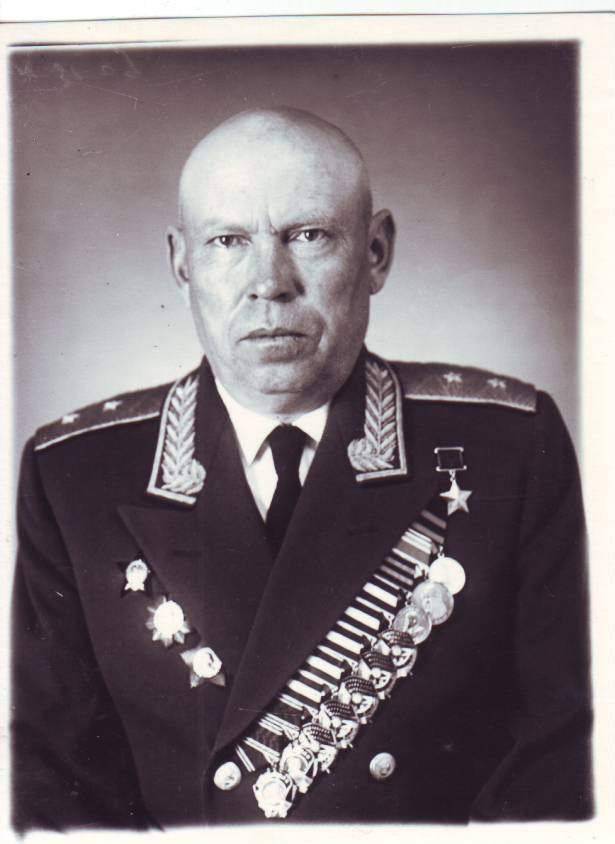
The commander of the 67-th Guards Rifle Division Alexei Ivanovich Baksov.
The 2 th SS tank corps on the first day of the battle acted more successfully than the 48 corps. During the day he fought wedged into the defense of the 6 Guards Army on 12-13 km, going into the area Bykovka - Kozmo-Demianovka. However, part of the SS could not meet the schedule of attack. The armored group of the SS division “Leibstantart Adolf Hitler” was supposed to advance approximately 30 km by the end of the first day of the offensive, reaching the crossings over the river Psel. The elite units of the German armed forces did not have to overcome a deep ditch, as the compounds of the 48 corps. But the resistance of the Soviet troops — the soldiers of the 52 Guards Rifle Division held defenses in this sector of the front — were so stubborn that the divisions of Dead Head had to send help to the first echelon divisions Leibstantart and Reich. 3-I tank-grenadier division of the SS "Totenkopf" was to enter the battle only after breaking through the first line of defense. And she was brought into battle in order to help the Reich division storm Berezovo. The day report of the Lebshtandart division, where 5-hour combat for 220,5 height is reported, speaks about the fierce fighting. Only after a powerful artillery bombardment and with the help of heavy Tiger tanks and assault guns, they took the height to the 11.30.
Despite the fierce resistance of the Soviet troops, parts of the SS corps slowly but steadily rushed forward. By the 18 hours after a fierce battle, the SS division "Leibstantart Adolf Hitler" took the Soviet stronghold on the Oboyan highway - Bykovka. The 2-th SS tank corps was able to break through the first line of defense of the 6-th Guards Army and reached the second line, which was defended by the 51-I Guards Rifle Division.
The more successful offensive of the 2 SS Panzer Corps is explained by the superiority of the corps over the 52-th Guards Division of Nekrasov and the underestimation of this front line by the Soviet command. It was assumed that the main blow is applied in the direction of Cherkassky. So it was, but the 4-I German Tank Army beat in two main directions. The air reconnaissance and the first 4 fights of July confirmed the direction of the attack on Cherkassy. Therefore, reserves were quickly transferred to the aid of the 67-th Guards Rifle Division. The 52 th anti-tank artillery brigade located in the rear of the 28 Guards Division was transferred to the aid of the guards only at the end of the day when the Germans had already pierced the defensive orders of the division. Also late with the transfer of anti-tank regiment of the orders of the neighboring 375-I infantry division.
In addition, a large role in breaking through the defenses of the 52 Guards Division was played by German aircraft, which inflicted massive strikes on Soviet troops. The German 4 Air Fleet made 5 July 2387 airplanes. The 58 aircraft of the 8 Air Ventry Vehicle has been lost or damaged. Soviet 2-I and 17-I air armies made 1768 sorties, they lost 159 machines in a day.
The successes of the German aviation during the Battle of Kursk were associated with several factors: 1) the centralized use of aviation and the maximum use of each aircraft (the machines made 2-3 departures per day); 2) more rational placement of take-off sites. During the battle, German landing sites for reconnaissance and communications aircraft were located in 5 – 7 km from the forward, and most of the field airfields were only 18 – 30 km from the forward (Soviet field airfields were located in 40 – 60 km from the forward; 3) in the communications, each German machine had a receiving and transmitting radio station, and the advanced German units had special aircraft manufacturers who were equipped with communication facilities connecting them with the headquarters of the air groups assigned to this sector of the front and squadron commanders, currently located in the air. In the Soviet fighter and assault aircraft, only the commanding personnel had radio transmitters, the ordinary pilots only had receivers.
The right neighbor of the 2 SS Panzer Corps - Kempf army group, on July 5 acted worst of all. She was unable to complete the task, faced with the stubborn resistance of the 7-th Guards Army formations. As a result, the left flank of the 2 tank corps was exposed, and it had to be covered by the forces of the Dead Head division.
Tankers in collaboration with infantry counterattack the enemy. Voronezh Front. 1943
To be continued ...
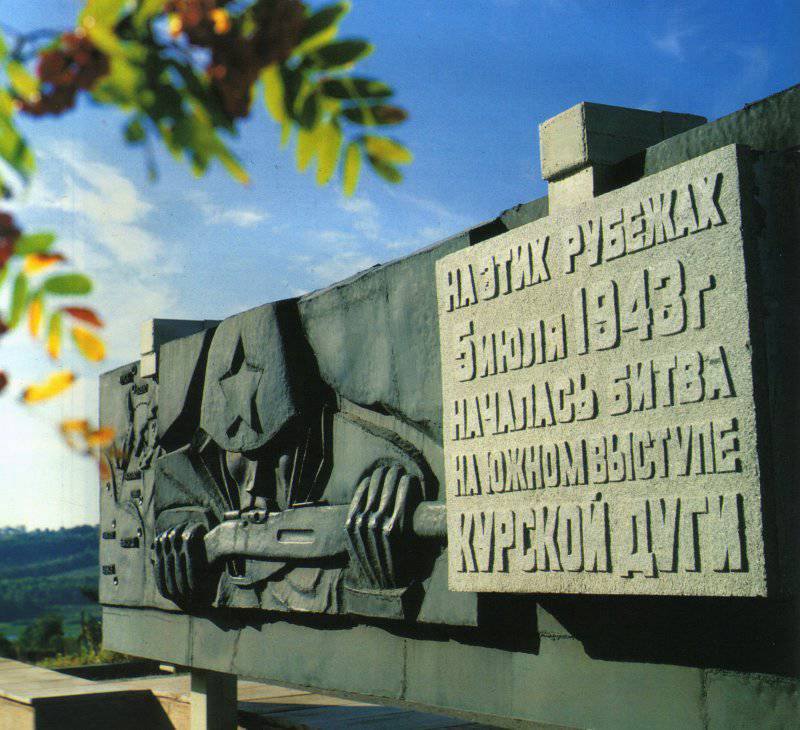
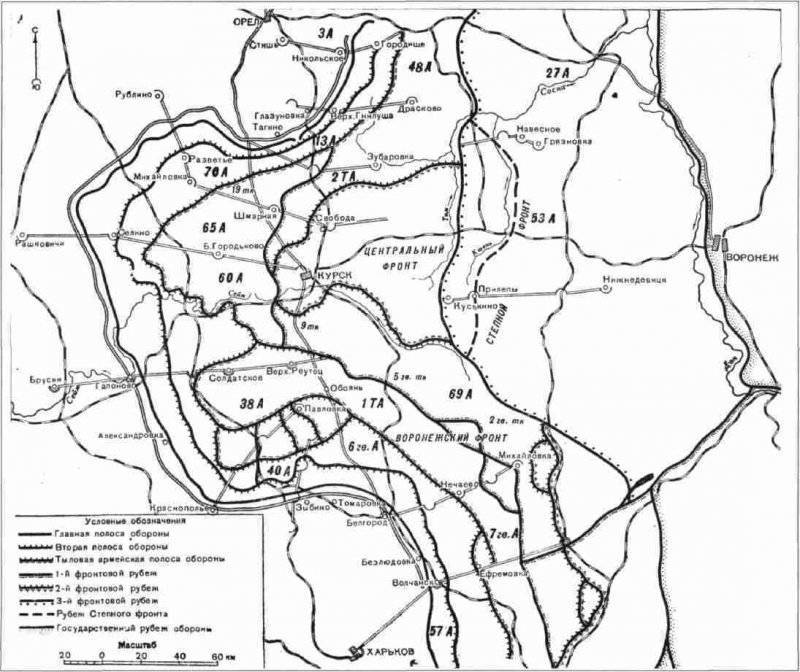
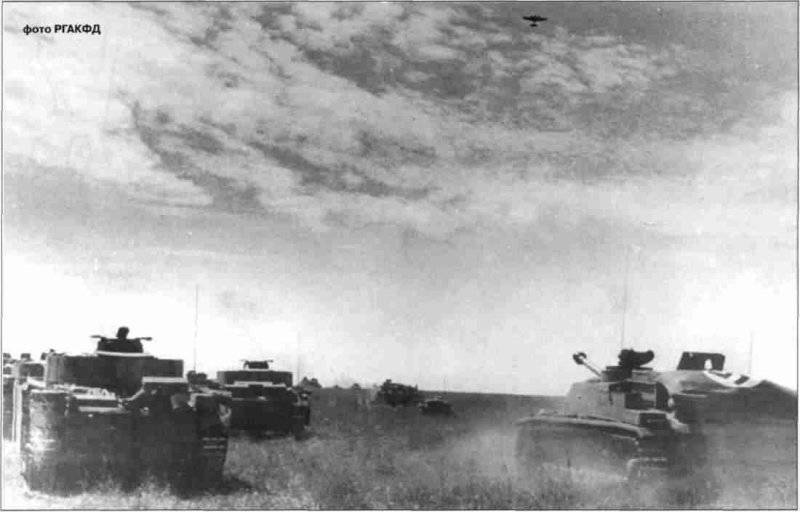
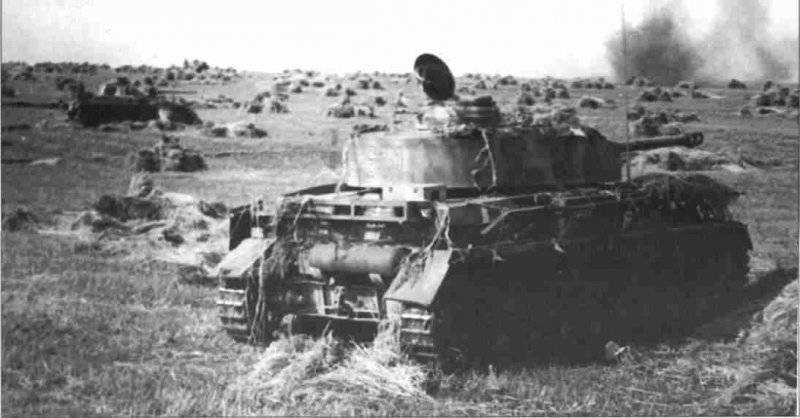
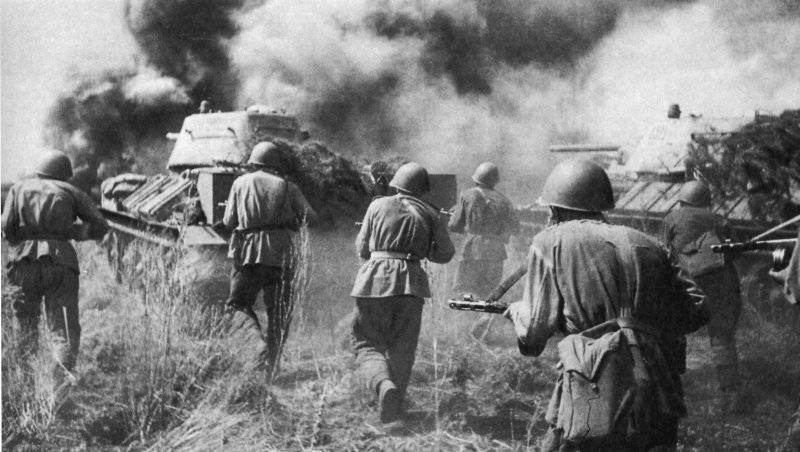
Information